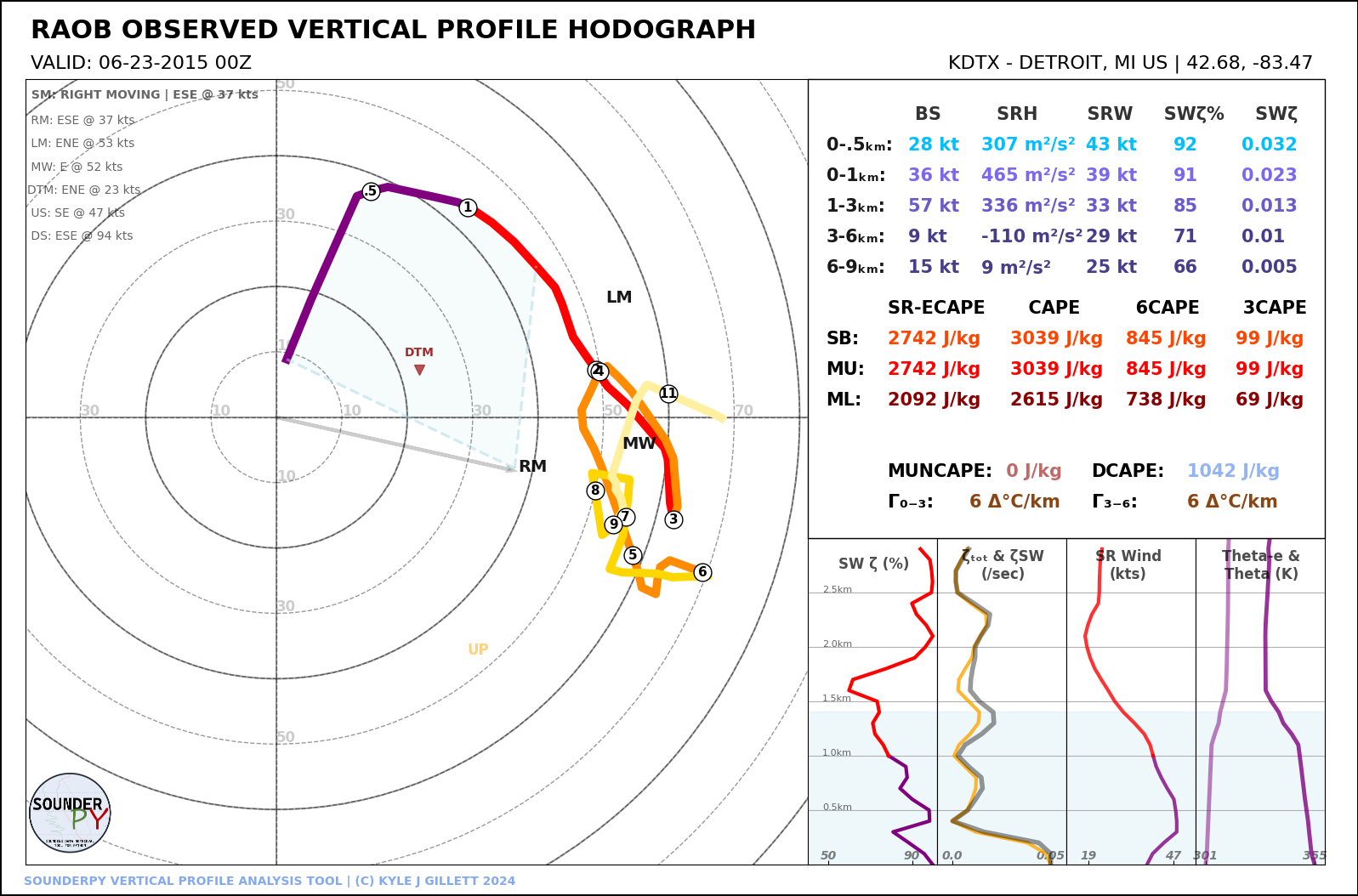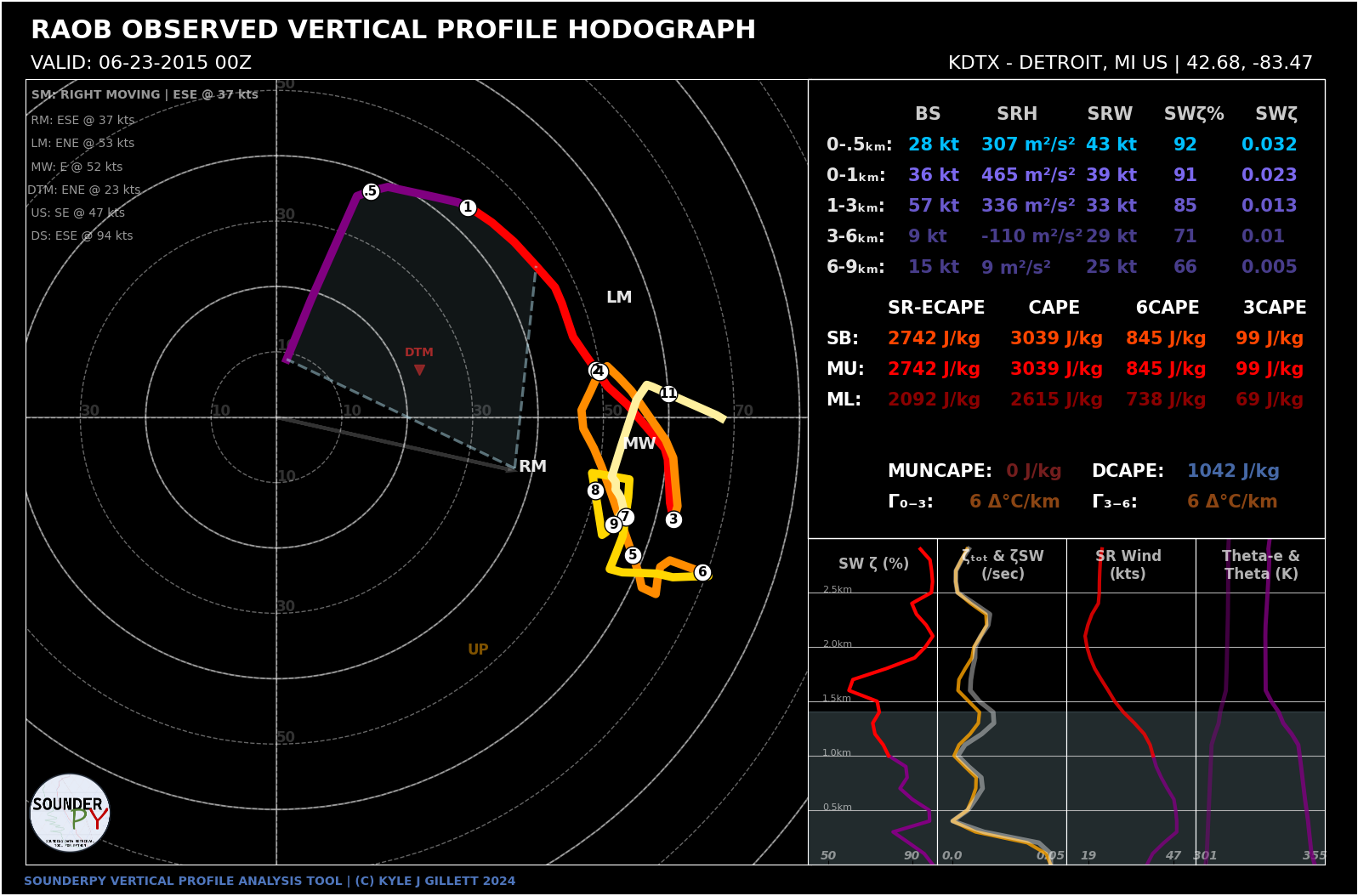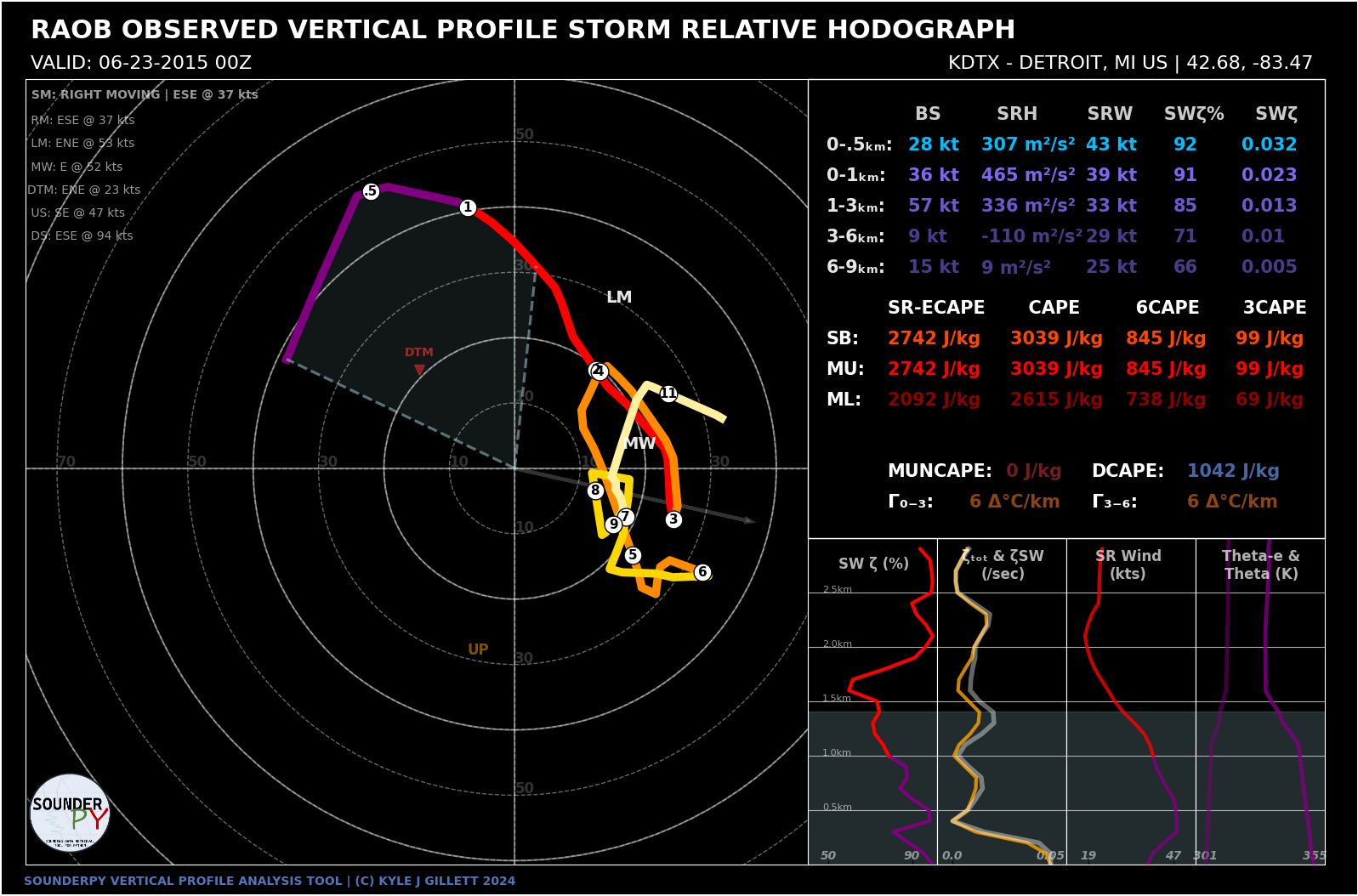Creating Hodograph Plots
This tutorial creates SounderPy Hodograph plots!
Here we will explore:
Building hodographs
Plots in dark mode
Storm relative hodographs
Saving hodograph plots to a file
[1]:
# First lets import SounderPy. Its fun to import as 'spy'!
import sounderpy as spy
## ---------------------------------- SOUNDERPY ----------------------------------- ##
## Vertical Profile Data Retrieval and Analysis Tool For Python ##
## v3.0.5 | Sept 2024 | (C) Kyle J Gillett ##
## Docs: https://kylejgillett.github.io/sounderpy/ ##
## --------------------- THANK YOU FOR USING THIS PACKAGE! ------------------------ ##
Load some data to plot
Here we can load some data with SounderPy.
Let’s investigate DTX (White Lake, MI) observations for a June tornado outbreak in 2015. We can use the get_obs_data() function to do this
[2]:
clean_data = spy.get_obs_data('dtx', '2015', '06', '23', '00')
> OBSERVED DATA ACCESS FUNCTION
-----------------------------------
> PROFILE FOUND: DTX on 06/23/2015 at 00z | From UW
> COMPLETE --------
> RUNTIME: 00:00:20
> SUMMARY: 00Z Launch for KDTX, DETROIT at 06-23-2015-00Z
> THERMODYNAMICS ---------------------------------------------
--- SBCAPE: 3039.4 | MUCAPE: 3039.4 | MLCAPE: 2615.3 | MUECAPE: 2742.7
--- MU 0-3: 99.9 | MU 0-6: 845.8 | SB 0-3: 99.9 | SB 0-6: 845.8
> KINEMATICS -------------------------------------------------
--- 0-500 SRW: 43.2 knot | 0-500 SWV: 0.032 | 0-500 SHEAR: 28.8 | 0-500 SRH: 308.0
--- 1-3km SRW: 33.1 knot | 1-3km SWV: 0.013 | 1-3km SHEAR: 57.3 | | 1-3km SRH: 336.0
==============================================================
Build a full hodograph plot
Here we use the most basic version of the build_hodograph() function.
[3]:
# light-mode hodograph
spy.build_hodograph(clean_data)
> HODOGRAPH PLOTTER FUNCTION --
-------------------------------
> RUNTIME: 00:00:01

Playing with hodograph settings
The plot above requried a very simple line of code.
Now we can adjust a few settings to customize the plot a little bit.
To do so, let’s first study the build_hodograph() function…
build_hodograph(clean_data, dark_mode=False, storm_motion='right_moving' sr_hodo=False, modify_sfc=None, save=False, filename='sounderpy_sounding')
where:
clean_data(dict, required) – the dictionary of data to be plotteddark_mode(bool, optional) – True will invert the color scheme for a ‘dark-mode’ sounding. Default is False.storm_motion(str or list of floats, optional) – the storm motion used for plotting and calculations. Default is ‘right_moving’. Custom storm motions are accepted as a list of floats representing direction and speed. Ex: [270.0, 25.0] where ‘270.0’ is the direction in degrees and ‘25.0’ is the speed in kts. See the documentation for more details.sr_hodo(bool, optional, default is False) – transform the hodograph from ground relative to storm relativesave(bool, optional) – whether to show the plot inline or save to a file. Default is False which displays the file inline.filename(str, optional) – the filename by which a file should be saved to if save = True. Default is ‘sounderpy_sounding’.modify_sfc: (None or dict, optional, default is None) - adictin the format{'T': 25, 'Td': 21, 'ws': 20, 'wd': 270}to modify the surface values of theclean_datadict. See the documentation for more details.
Lets try the dark_mode setting:
[4]:
# dark_mode turned on!
spy.build_hodograph(clean_data, dark_mode=True)
> HODOGRAPH PLOTTER FUNCTION --
-------------------------------
> RUNTIME: 00:00:01

Storm relative hodographs
A storm-relative hodograph is a hodograph centered on the storm-motion. In this way we can think more about what the “storm feels”.
A storm-relative hodograph “normalizes all of the seemingly-infinite hodograph shapes into what the supercell actually experiences” - Cameron J Nixon (read more here: https://cameronjnixon.wordpress.com/research/hodographs/)
To create a SounderPy storm relative hodograph, simply use the sr_hodo kwarg, set it equl to True.
NOTE
This will only work if a storm motion exists.
The storm motion defaults to Bunkers Right Moving, but this can be changed with the
storm_motionkwarg.A vertical profile must be over 6km tall for the Bunkers calculation to work, so profiles below this height will still be ‘ground-relative’
[5]:
# storm-relative hodograph!
spy.build_hodograph(clean_data, dark_mode=True, sr_hodo=True)
> HODOGRAPH PLOTTER FUNCTION --
-------------------------------
> RUNTIME: 00:00:01

Saving plots as a file
By default, SounderPy is set to show plots inline. If you want/need to save them to a file, SounderPy offers that option!
Just set the save kwarg to True, and give it a file name using the filename kwarg!
IMPORTANT NOTE!!!
If your plots come out with a funky layout when displaying them inline, it may be due to your screen resolution.
In the event that this is the case, simply use the
save=Trueoption to save plots to a file!
[7]:
#spy.build_hodograph(clean_data, save=True, filename='sounderpy_2015062300z_DTX')
[ ]: